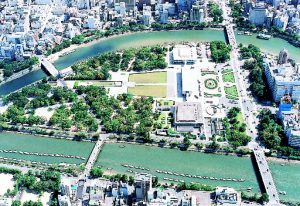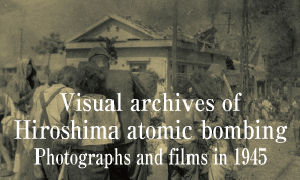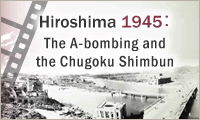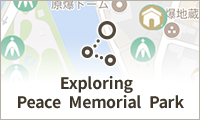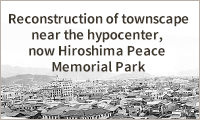Chugoku Shimbun survey confirms 163 killed in A-bombing in former Tenjin-machi Kitagumi, vanished neighborhood and site of planned National Peace Memorial Hall — former residents want “record to be passed on to future generations”
Oct. 15, 1998
On October 14, 1998, based on cooperation received from bereaved family members, the Chugoku Shimbun compiled a report on the circumstances of devastation in the former Tenjin-machi Kitagumi area, the site on which Japan’s national government is planning to build the Hiroshima National Peace Memorial Hall for the Atomic Bomb Victims in Peace Memorial Park, located in Hiroshima City’s Naka Ward. The area was instantly destroyed in the atomic bombing of the city. By the end of 1945, the year of the bombing, 163 deaths had been confirmed. The remains of nearly half that number, or 77 people, have never been found. Bereaved families are urging the Japanese and Hiroshima City governments to preserve a record of the people whose very proof of existence was erased by the bombing.
A total of 146 people from 57 households who had been living in the former Tenjin-machi Kitagumi area, located within 500 meters of the hypocenter, until August 6 died in the atomic bombing. Seventeen people died in the area while working as live-in workers, visiting relatives, or while at work there. The highest number of victims in a single family was seven people, and two families were completely wiped out.
On August 6, 1945, many of the bereaved family members who suddenly lost their relatives also experienced the bombing at sites where they had been mobilized to work as students or where they had been conscripted for work. Unable to confirm their relatives’ remains, one person said, “I estimated where my home had been and told myself they might have died right around here.” One man, who had been left alone after losing both parents in the atomic bombing, was so traumatized that he had hesitated to apply for an Atomic Bomb Survivor’s Certificate until this year. The oldest bereaved family member from the area is a 91-year-old woman from Asaminami Ward who had entered Hiroshima shortly after the bombing in search of her husband.
Peace Memorial Park was built in the former Tenjin-machi Kitagumi area under the Hiroshima Peace Memorial City Construction Law, enacted by the national government in 1949. As a result, residents were unable to return to places familiar to them. Kimie Honma, 75, who was born in the Tenjin-machi 14 ban-chi area and moved to Kobe City after experiencing the atomic bombing, said, “I had lost my grandmother, who looked after me in place of my parents, and my hometown was also gone. To convey the value of peace without forgetting the dead, I hope the circumstances of the devastation can be properly preserved on record and passed down to future generations.”
Peace Memorial Hall is scheduled to be built in the area where the monument to the former Kitagumi area is located, starting next fiscal year. It will have two underground floors and a total floor area of 3,000 square meters. The hall is scheduled to open in 2002. Japan’s Ministry of Health and Welfare said it would “show the number of fatalities by representing A-bomb victims through handprints or human figures” as a way to mourn the dead, based on recommendations from an advisory panel it received in September. The national government takes a passive stance with respect to obtaining, preserving, and displaying records of A-bomb victims.
Satoru Ubuki, associate professor at Hiroshima University’s Research Institute for Nuclear Medicine and Biology, said, “If we are to mourn the victims, we need to express human grief by recording the details of the situation of devastation experienced by each and every person. To clarify the reality of the atomic bombing, especially since even the total number of deaths remains unclear, the national government has a duty to organize and integrate surveys carried out by the Hiroshima City government and A-bomb survivors’ groups and pass them on as a part of history.”
(Originally published on October 15, 1998)
A total of 146 people from 57 households who had been living in the former Tenjin-machi Kitagumi area, located within 500 meters of the hypocenter, until August 6 died in the atomic bombing. Seventeen people died in the area while working as live-in workers, visiting relatives, or while at work there. The highest number of victims in a single family was seven people, and two families were completely wiped out.
On August 6, 1945, many of the bereaved family members who suddenly lost their relatives also experienced the bombing at sites where they had been mobilized to work as students or where they had been conscripted for work. Unable to confirm their relatives’ remains, one person said, “I estimated where my home had been and told myself they might have died right around here.” One man, who had been left alone after losing both parents in the atomic bombing, was so traumatized that he had hesitated to apply for an Atomic Bomb Survivor’s Certificate until this year. The oldest bereaved family member from the area is a 91-year-old woman from Asaminami Ward who had entered Hiroshima shortly after the bombing in search of her husband.
Peace Memorial Park was built in the former Tenjin-machi Kitagumi area under the Hiroshima Peace Memorial City Construction Law, enacted by the national government in 1949. As a result, residents were unable to return to places familiar to them. Kimie Honma, 75, who was born in the Tenjin-machi 14 ban-chi area and moved to Kobe City after experiencing the atomic bombing, said, “I had lost my grandmother, who looked after me in place of my parents, and my hometown was also gone. To convey the value of peace without forgetting the dead, I hope the circumstances of the devastation can be properly preserved on record and passed down to future generations.”
Peace Memorial Hall is scheduled to be built in the area where the monument to the former Kitagumi area is located, starting next fiscal year. It will have two underground floors and a total floor area of 3,000 square meters. The hall is scheduled to open in 2002. Japan’s Ministry of Health and Welfare said it would “show the number of fatalities by representing A-bomb victims through handprints or human figures” as a way to mourn the dead, based on recommendations from an advisory panel it received in September. The national government takes a passive stance with respect to obtaining, preserving, and displaying records of A-bomb victims.
Satoru Ubuki, associate professor at Hiroshima University’s Research Institute for Nuclear Medicine and Biology, said, “If we are to mourn the victims, we need to express human grief by recording the details of the situation of devastation experienced by each and every person. To clarify the reality of the atomic bombing, especially since even the total number of deaths remains unclear, the national government has a duty to organize and integrate surveys carried out by the Hiroshima City government and A-bomb survivors’ groups and pass them on as a part of history.”
(Originally published on October 15, 1998)

